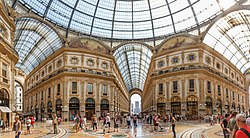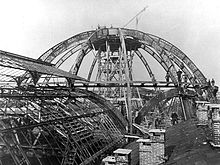Galleria Vittorio Emanuele II
 | |
 | |
| Location | Milan, Italy |
|---|---|
| Coordinates | 45°27′56″N 9°11′24″E / 45.46556°N 9.19000°E |
| Opening date | 1877 |
| Owner | Comune of Milan |
| Architect | Giuseppe Mengoni |
| Public transit access | |
The Galleria Vittorio Emanuele II (Italian:
Architecture

The structure consists of two glass-vaulted arcades intersecting in an
The central octagonal space is topped with a glass dome. The Milanese Galleria was larger in scale than its predecessors and was an important step in the evolution of the modern glazed and enclosed shopping mall, of which it was the direct progenitor. It has inspired the use of the term galleria for many other shopping arcades and malls.[2]
On the ground of the central octagonal, there are four mosaics portraying the coat of arms of the three capitals of the Kingdom of Italy (Turin, Florence and Rome) plus Milan's. Tradition says that if a person spins around three times with a heel on the testicles of the bull from Turin coat of arms this will bring good luck. This practice causes damage to the mosaic: a hole developed on the place of the bull's genitals.[3]
The Galleria connects two of Milan's most famous landmarks: The Duomo and the Teatro Alla Scala, but the Galleria is a landmark in its own right.
The iron-and-glass roof
The Milan gallery and its roof have been acknowledged as an important reference on 19th-century iron-and-glass architecture by Pevsner[4] and Hitchcock.[5] As one can still observe today, the roof consists of four barrel vaults (approximately 14.5 m in width and 8.5 m in height) that are crowned with a huge dome (around 37.5 m as internal diameter and 17.10 m in height).[6] Jorini pointed out the accomplishments of this dome with special regard to the large dimensions.[7] Each of the roof parts is topped with a lantern.

According to Geist, the Milan gallery and the roof were unprecedented in dimensions by previously built shopping arcades.
The historical roof was heavily damaged during the aerial bombings of World War II.[22][23] Before that the roof had undergone multiple maintenance interventions.[24] Serious problems in the roof were reported in the 1970s,[25] and some of them were solved in the 1980s.[26] The roof that we see today has gone through different historic modifications and represents complicated conservation issues.[27] In 2015, in preparation for Expo Milano 2015, the facades, statues, and mosaics underwent detailed cleaning and repair, using a giant moving crane scaffolding system. [28]
Shops, restaurants and hotels

The Galleria is often nicknamed il salotto di Milano (Milan's drawing room), due to its numerous shops and importance as a common Milanese meeting and dining place.[29]
As of 2013, the arcade principally contains luxury retailers selling
Gallery
-
Galleria Vittorio Emanuele II at Christmas
-
Galleria Vittorio Emanuele II from inside the arcade, c. 1880
-
The Galleria Vittorio Emanuele II's first stone
-
The Galleria's triumphal arch entrance
-
The Galleria from inside the arcade
-
Detail of the exedra at the exit of the gallery on Piazza della Scala
-
Floor mosaic
-
Vertical photo of Galleria Vittorio Emanuele
References
- ^ "Milan: overview", Insight Guides website, London, England, U.K.: Apa Publications UK, 2012, archived from the original on October 5, 2012, retrieved October 18, 2012,
To the north is the entrance to the Galleria Vittorio Emanuele, Italy's oldest and most elegant shopping gallery. Its four-storey arcade has many boutiques, bookshops, bars and restaurants.
- ^ Massey, Anne; Arnold, Dana (2019). A Companion to Contemporary Design Since 1945. Wiley. p. 125.
- ISBN 978-88-7332-282-5.
- ^ Pevsner, N. (1976). A History of Building Types. Princeton, JC: Princeton University Press. pp. 265.
- ^ Hitchcock, H.-R. (1977). Architecture: Nineteenth and Twentieth Centuries. Harmondsworth: Penguin books. pp. 75, 120, 146.
- ISBN 88-7685-022-8.
- ^ Jorini, A. F. (1892). "La cupola della Galleria Vittorio Emanuele II a Milano". L'Edilizia Moderna. 2: 4–6: 6.
- ^ Geist, J. F. (1985). Arcades: The History of a Building Type. Cambridge, MA: MIT Press. pp. 100, 101, 371.
- ISBN 978-3-319-08532-6.
- ^ Jodice, R. (1985). L'architettura del ferro. L'Italia, 1796–1914. Roma: Bulzoni. p. 274.
- ISSN 0267-7768.
- ^ Geist, Arcades: 75, 77
- ^ Chizzolini & Poggi, Piazza del Duomo: 216.
- ^ Idem.: 217.
- ^ Geist, Arcades: 97–99.
- ^ Ibidem.
- ^ Bertels, Wouters & Stoyanova, Glazed wrought-iron arcades: 55.
- ^ Saldini, ed. (1885). "La copertura della Galleria Vittorio Emanuele di Milano". L'architettura del ferro: raccolta di motivi per costruzioni civili, ferroviarie ed artistiche compilata col concorso dei migliori ingegneri, architetti e costruttori italiani. Milano: Prem. Litog. e Tipog. degli ingegneri.
- ^ Selvafotla, O. (1983). "La Galleria Vittorio Emanuele". In Castellano, A.; Selvafolta, O. (eds.). Aspetti e problemi di storia edilizia. Milano: Electa. p. 245.
- ISBN 978-0-9928751-2-1.
- ^ Stoyanova, Promoting: 260.
- ^ Gianforma, G. (1959). Il salotto di Milano. Milano: Tip. L. maestri. pp. 33–35.
- ^ Rondello, A. (1967). La galleria Vittorio Emanuele 2. Milano: Itala ars. pp. 277–295.
- ISBN 978-1-84564-968-5.
- ^ Vallatta, A. (1981) Relazione sullo stato delle strutture in ferro della copertura della Galleria Vittorio Emanuele II. Milano: Comune di Milano.
- ^ Gianni, G. (1989). "Restauro della Galleria Vittorio Emanuele II a Milano". In Gimma, M. G. (ed.). I materiali metallici negli interventi di restauro e recupero edilizio: atti del convegno e mostra 18-19-20 maggio 1989. Roma: BetaGamma. p. 199.
- ^ Stoyanova, The Iron-Glass Roof: 82–84.
- ^ Crow, Melinda (2017-08-01). "Milan: The Duomo and the Galleria". FirstRead.Me. Retrieved 2017-08-01.
- ^ Insight Guides (2004) p.220.
- ^ ‘Gran Caffè Biffi’, Luigi’s Mailorder.
- ^ ‘Il Biffi’ Archived 2010-01-05 at the Wayback Machine, Biffi in Galleria.
- ^ ‘I Bar Storici Di Milano’ Archived 2012-03-01 at the Wayback Machine, cookaround.com.
Further reading
- Geist, Johann F. (1982), Arcades: The History of a Building Type, MIT Press, ISBN 0-262-07082-0
- Insight Guides (2004), Northern Italy, APA Publications, ISBN 981-234-903-0









